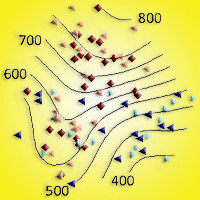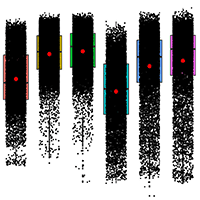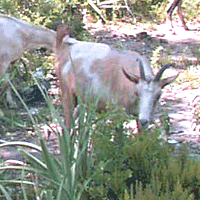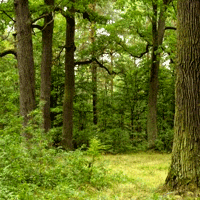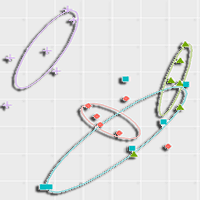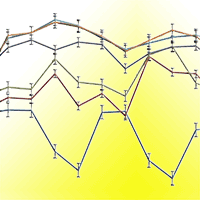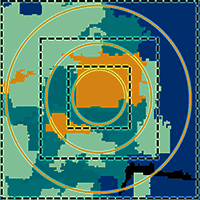European heathland habitats are cultural landscapes derived from previously-forested ecosystems. Heathlands are of significant conservation interest but have experienced prolonged degradation due to a range of factors including overgrazing by domestic livestock. There is growing recognition of the need to restore upland landscapes to produce a diverse mosaic of woodlands, heathlands and forest edge ecotones. In some studies stock removal has been sufficient to promote heathland recovery, but often more intensive interventions are required. Few studies have specifically examined how abiotic gradients associated with changing elevation might relate to restoration success. We examined differences in vegetation between grazed and restored areas over a 500 m elevational gradient split across two hillsides that were part of a landscape-scale restoration project in the Scottish Southern Uplands. Species alpha and gamma diversity showed non-linear responses to elevation but the effects of grazing differed between sites. Grazing increased diversity on the lower elevation site but reduced it at higher elevations. The differing effects of grazing with elevation can be interpreted in the context of levels of competition and likely impacts on rates of colonization and extinction. Differences in community composition were assessed using PERMANOVA, NMDS and Cluster Analysis and were primarily controlled by elevation with no significant effect of grazing. The keystone heathland species Calluna vulgaris was not recorded in any of our monitoring plots but some other dwarf shrubs were common. Changes in community structure following stock removal are slow on upland sites but initial impacts interact strongly with abiotic site conditions and pre-restoration vegetation composition. During large-scale restoration it is therefore vital to consider how widely-applied treatments might differ in their effects across landscapes. Changes in diversity may provide a useful early indicator of important ecological processes and likely directions of change.
Keywords
, , , , , ,
Citation
Davies GM, Bodart J (2015). Changes in vegetation diversity and composition following livestock removal along an upland elevational gradient. iForest 8: 582-589. - doi: 10.3832/ifor1557-008
Academic Editor
Arthur Gessler
Paper history
Received: Jan 12, 2015
Accepted: Mar 18, 2015
First online: Apr 22, 2015
Publication Date: Oct 01, 2015
Publication Time: 1.17 months
© SISEF - The Italian Society of Silviculture and Forest Ecology 2015
Open Access
This article is distributed under the terms of the Creative Commons Attribution-Non Commercial 4.0 International (https://creativecommons.org/licenses/by-nc/4.0/), which permits unrestricted use, distribution, and reproduction in any medium, provided you give appropriate credit to the original author(s) and the source, provide a link to the Creative Commons license, and indicate if changes were made.

Breakdown by View Type
(Waiting for server response...)
Article Usage
Total Article Views: 57557
(from publication date up to now)
Breakdown by View Type
HTML Page Views: 47388
Abstract Page Views: 3152
PDF Downloads: 5599
Citation/Reference Downloads: 32
XML Downloads: 1386
Web Metrics
Days since publication: 3865
Overall contacts: 57557
Avg. contacts per week: 104.24
Article Citations
Article citations are based on data periodically collected from the Clarivate Web of Science web site
(last update: Mar 2025)
Total number of cites (since 2015): 13
Average cites per year: 1.18
Publication Metrics
by Dimensions ©
Articles citing this article
List of the papers citing this article based on CrossRef Cited-by.
(1)
Adair S (2009)Corehead National Vegetation Classification Survey with comments on management proposals. Full Report, Borders Forest Trust, Jedburgh, Scotland, pp. 38.
Gscholar
(2)
Alonso I, Hartley SE, Thurlow M (2009)Competition between heather and grasses on Scottish moorlands: Interacting effects of nutrient enrichment and grazing regime. Journal of Vegetation Science 12: 249-260.
CrossRef |
Gscholar
(3)
Anderson P, Radford E (1994)Changes in vegetation following reduction in grazing pressure on the National Trust’s Kinder Estate, Peak District, Derbyshire, England. Biological Conservation 69: 55-63.
CrossRef |
Gscholar
(4)
Anderson MJ (2001)A new method for non-parametric multivariate analysis of variance. Austral Ecology 26: 32-46.
CrossRef |
Gscholar
(5)
Anderson MJ, Ellingsen KE, McArdle BH (2006)Multivariate dispersion as a measure of beta diversity. Ecology Letters 9: 683-693.
CrossRef |
Gscholar
(6)
Ascoli D, Lonati M, Marzano R, Bovio G, Cavallero A, Lombardi G (2013)Prescribed burning and browsing to control tree encroachment in southern European heathlands. Forest Ecology and Management 289: 69-77.
CrossRef |
Gscholar
(7)
Bakker J, Berendse F (1999)Constraints in the restoration of ecological diversity in grassland and heathland communities. Trends in Ecology and Evolution 14: 63-68.
CrossRef |
Gscholar
(8)
Bennion H, Carvalho L, Sayer CD, Simpson GL, Wischnewski J (2012)Identifying from recent sediment records the effects of nutrients and climate on diatom dynamics in Loch Leven. Freshwater Biology 57: 2015-2029.
CrossRef |
Gscholar
(9)
Bobbink R, Hettelingh JS (2011)Review and revision of empirical critical loads and dose-response relationships. In: Proceedings of an expert workshop. Noordwijkerhout (Netherlands), 23-25 Jun 2010. Coordination Centre for Effects, National Institute for Public Health and the Environment (RIVM), Bilthoven, The Netherlands, pp. 246.
Gscholar
(10)
Bokdam J, Gleichman JM (2000)Effects of grazing by free-ranging cattle on vegetation dynamics in a continental north-west European heathland. Journal of Applied Ecology 37: 415-431.
CrossRef |
Gscholar
(11)
Britton AJ, Fisher JM (2007)Interactive effects of nitrogen deposition, fire and grazing on diversity and composition of low-alpine prostrate
Calluna vulgaris heathland. Journal of Applied Ecology 44: 125-135.
CrossRef |
Gscholar
(12)
Britton AJ, Pearce ISK, Jones B (2005)Impacts of grazing on montane heath vegetation in Wales and implications for the restoration of montane areas. Biological Conservation 125: 515-524.
CrossRef |
Gscholar
(13)
Bullock JM, Pakeman RJ (1997)Grazing of lowland heath in England: management methods and their effects on healthland vegetation. Biological Conservation 79: 1-13.
CrossRef |
Gscholar
(14)
Colwell RK, Gotelli NJ, Rahbek C, Entsminger GL, Farrell C, Graves GR (2009)Peaks, plateaus, canyons, and craters: the complex geometry of simple mid-domain effect models. Evolutionary Ecology Research 11: 355-370.
Online |
Gscholar
(15)
Common TG, Wright IA, Grant SA (1998)The effect of grazing by cattle on animal performance and floristic composition in
Nardus-dominated swards. Grass and Forage Science 53: 260-269.
CrossRef |
Gscholar
(16)
Critchley CNR, Adamson HF, Mclean BML, Davies OD (2008)Vegetation dynamics and livestock performance in system-scale studies of sheep and cattle grazing on degraded upland wet heath. Agriculture, Ecosystems and Environment 128: 59-67.
CrossRef |
Gscholar
(17)
Critchley CNR, Mitchell RJ, Rose RJ, Griffiths JB, Jackson E, Scott H, Davies OD (2013)Re-establishment of
Calluna vulgaris (L.) Hull in an eight-year grazing experiment on upland acid grassland. Journal for Nature Conservation 21: 22-30.
CrossRef |
Gscholar
(18)
D’Odorico P, Okin GS, Bestelmeyer BT (2012)A synthetic review of feedbacks and drivers of shrub encroachment in arid grasslands. Ecohydrology 5: 520-530.
CrossRef |
Gscholar
(19)
Fagúndez J (2012)Heathlands confronting global change: drivers of biodiversity loss from past to future scenarios. Annals of Botany 111 (2): 151-172.
CrossRef |
Gscholar
(20)
Fernandes PM, Davies GM, Ascoli D, Fernández C, Moreira F, Rigolot E, Stoof CR, Vega JA, Molina D (2013)Prescribed burning in southern Europe: developing fire management in a dynamic landscape. Frontiers in Ecology and the Environment 11: e4-e14.
CrossRef |
Gscholar
(21)
Fottner S, Härdtle W, Niemeyer M, Niemeyer T, Von Oheimb G, Meyer H, Mockenhaupt M (2007)Impact of sheep grazing on nutrient budgets of dry heathlands. Applied Vegetation Science 10: 391-398.
CrossRef |
Gscholar
(22)
Fraser MD, Theobald VJ, Dhanoa MS, Davies OD (2011)Impact on sward composition and stock performance of grazing
Molinia-dominant grassland. Agriculture, Ecosystems and Environment 144: 102-106.
CrossRef |
Gscholar
(23)
Friedrich U, Von Oheimb G, Dziedek C, Kriebitzsch W, Selbmann K, Härdtle W (2011)Mechanisms of purple moor-grass (
Molinia caerulea) encroachment in dry heathland ecosystems with chronic nitrogen inputs. Environmental Pollution 159: 3553-3559.
CrossRef |
Gscholar
(24)
García RR, Fraser MD, Celaya R, Mendes Ferreira LM, García U, Garcia KO (2013)Grazing land management and biodiversity in the Atlantic European heathlands: a review. Agroforestry Systems 87: 19-43.
CrossRef |
Gscholar
(25)
Grant SA, Torvell L, Sim EM, Small JL, Armstrong RH (1996)Controlled grazing studies on
Nardus grassland: effects of between-tussock sward height and species of grazer on
Nardus utilization and floristic composition in two fields in Scotland. Journal of Applied Ecology 33: 1053-1064.
CrossRef |
Gscholar
(26)
Grytnes JA, Heegaard E, Romdal TS (2008)Can the mass effect explain the mid-altitudinal peak in vascular plant species richness? Basic and Applied Ecology 9: 373-382.
CrossRef |
Gscholar
(27)
Hargrove WW, Pickering J (1992)Pseudoreplication: a
sine qua non for regional ecology. Landscape Ecology 6: 251-258.
CrossRef |
Gscholar
(28)
Hester AJ, Miller DR, Towers W (1996)Landscape-scale vegetation change in the Cairngorms, Scotland, 1946-1988: implications for land management. Biological Conservation 77: 41-51.
CrossRef |
Gscholar
(29)
Hobbs R (2009)Woodland restoration in Scotland: ecology, history, culture, economics, politics and change. Journal of Environmental Management 90: 2857-2865.
CrossRef |
Gscholar
(30)
Hulme PD, Pakeman RJ, Torvell L, Fisher JM, Gordon IJ (1999)The effects of controlled sheep grazing on the dynamics of upland
Agrostis-Festuca grassland. Journal of Applied Ecology 36: 886-900.
CrossRef |
Gscholar
(31)
Hulme PD, Merrell BG, Torvell L, Fisher JM, Small JL, Pakeman RJ (2002)Rehabilitation of degraded
Calluna vulgaris (L.) Hull-dominated wet heath by controlled sheep grazing. Biological Conservation 107: 351-363.
CrossRef |
Gscholar
(32)
Humphrey JW, Ferris F, Quine CP (2003)Biodiversity in Britain’s planted forests. Forestry Commission, Edinburgh, UK, pp. 117.
Online |
Gscholar
(33)
Hurlbert SH (1984)Pseudoreplication and the design of ecological field experiments. Ecological Monographs 54 (2): 187-211.
CrossRef |
Gscholar
(34)
Kozlov MV, Hurlbert SH (2006)Pseudoreplication, chatter, and the international nature of science: a response to DV Tatarnikov. Journal of Fundamental Biology (Moscow) 67: 145-152.
Online |
Gscholar
(35)
Körner C (2007)The use of “altitude” in ecological research. Trends in Ecology and Evolution 22: 569-574.
CrossRef |
Gscholar
(36)
Littlewood NA, Pakeman RJ, Woodin SJ (2006)A field assessment of the success of moorland restoration in the rehabilitation of whole plant assemblages. Applied Vegetation Science 9: 295-306.
CrossRef |
Gscholar
(37)
Littlewood NA, Greenwood S, Quin SLO, Pakeman RJ, Woodin SJ (2014)Long-term trends in restored moorland vegetation assemblages. Community Ecology 15: 104-112.
CrossRef |
Gscholar
(38)
Lomolino MV (2001)Elevation gradients of species density: historical and prospective views. Global Ecology and Biogeography 10: 3-13.
CrossRef |
Gscholar
(39)
Maddock A (2011)UK biodiversity action plan priority habitat descriptions. JNCC, Peterborough, UK, pp. 100.
Online |
Gscholar
(40)
Marrs RH, Phillips JDP, Todd PA, Ghorbani J, Le Duc MG (2004)Control of
Molinia caerulea on upland moors. Journal of Applied Ecology 41: 398-411.
CrossRef |
Gscholar
(41)
Mitchell RJ, Rose RJ, Palmer SCF (2008)Restoration of
Calluna vulgaris on grass-dominated moorlands: the importance of disturbance, grazing and seeding. Biological Conservation 141: 2100-2111.
CrossRef |
Gscholar
(42)
Moleele NM, Perkins JS (1998)Encroaching woody plant species and boreholes: is cattle density the main driving factor in the Olifants Drift communal grazing lands, south-eastern Botswana? Journal of Arid Environments 40: 245-253.
CrossRef |
Gscholar
(43)
Newton AC, Stewart GB, Myers G, Diaz A, Lake S, Bullock JM, Pullin AS (2009)Impacts of grazing on lowland heathland in north-west Europe. Biological Conservation 142: 935-947.
CrossRef |
Gscholar
(44)
Oksanen L (2001)Logic of experiments in ecology: is pseudoreplication a pseudoissue? Oikos 94: 27-38.
CrossRef |
Gscholar
(45)
Oksanen J, Blanchet FG, Kindt R, Legendre P, Minchin PR, O’Hara RB, Simpson GL, Solymos P, Stevens MHH, Wagner H (2014)vegan: community Ecology Package. R package version 2.0-3, web resource.
Online |
Gscholar
(46)
Olff H, Ritchie ME (1998)Effects of herbivores on grassland plant diversity. Trends in Ecology and Evolution 13: 261-265.
CrossRef |
Gscholar
(47)
Pakeman RJ (2004)Consistency of plant species, trait responses to grazing along a productivity gradient: a multi-site analysis. Journal of Ecology 92: 893-905.
CrossRef |
Gscholar
(48)
Pakeman R, Hulme PD, Torvell L, Fisher JM (2003)Rehabilitation of degraded dry heather (
Calluna vulgaris (L.) Hull) moorland by controlled sheep grazing. Biological Conservation 114: 389-400.
CrossRef |
Gscholar
(49)
R Development Core Team (2012)R: a language and environment for statistical computing. R Foundation for Statistical Computing, Vienna, Austria.
Online |
Gscholar
(50)
Rawes M (1981)Further results of excluding sheep from high-level grasslands in the North Pennines. Journal of Ecology 69: 651-669.
CrossRef |
Gscholar
(51)
Rodwell JS (1992)British plant communities: volume 3. Grasslands and montane communities. Cambridge University Press, Cambridge, UK, pp. 552.
Gscholar
(52)
Soil Survey of Scotland Staff (1981)Soil maps of Scotland at a scale of 1:250 000. Macaulay Institute for Soil Research, Aberdeen, Scotland, UK.
Online |
Gscholar
(53)
Stace C (2010)New flora of the British isles. Cambridge University Press, Cambridge, UK, pp. 1236.
Online |
Gscholar
(54)
Stevenson AC, Thompson DBA (1993)Long-term changes in the extent of heather moorland in upland Britain and Ireland: palaeoecological evidence for the importance of grazing. The Holocene 3: 70-76.
CrossRef |
Gscholar
(55)
Suding KN, Gross KL, Houseman GR (2004)Alternative states and positive feedbacks in restoration ecology. Trends in Ecology and Evolution 19: 46-53.
CrossRef |
Gscholar
(56)
Thompson DBA, MacDonald AJ, Marsden JH, Galbraith CA (1995)Upland heather moorland in Great Britain: a review of international importance, vegetation change and some objectives for nature conservation. Biological Conservation 71: 163-178.
CrossRef |
Gscholar
(57)
Vandvik V, Heegaard E, Måren IE, Aarrestad PA (2005)Managing heterogeneity: the importance of grazing and environmental variation on post-fire succession in heathlands. Journal of Applied Ecology 42: 139-149.
CrossRef |
Gscholar
(58)
Verhagen R, Klooker J, Bakker JP, Van Diggelen R (2001)Restoration success of low-production plant communities on former agricultural soils after top-soil removal. Applied Vegetation Science 4: 75-82.
CrossRef |
Gscholar
(59)
Watt AS, Jones EW (1948)The ecology of the Cairngorms: part 1. The environment and the altitudinal zonation of the vegetation. Journal of Ecology 36: 283-304.
CrossRef |
Gscholar
(60)
Webb NR (1998)The traditional management of European heathlands. Journal of Applied Ecology 35: 987-990.
CrossRef |
Gscholar
(61)
Welch D, Scott D (1995)Studies in the grazing of heather moorland in northeast Scotland. VI. 20-year trends in botanical composition. Journal of Applied Ecology 32: 596-611.
CrossRef |
Gscholar
